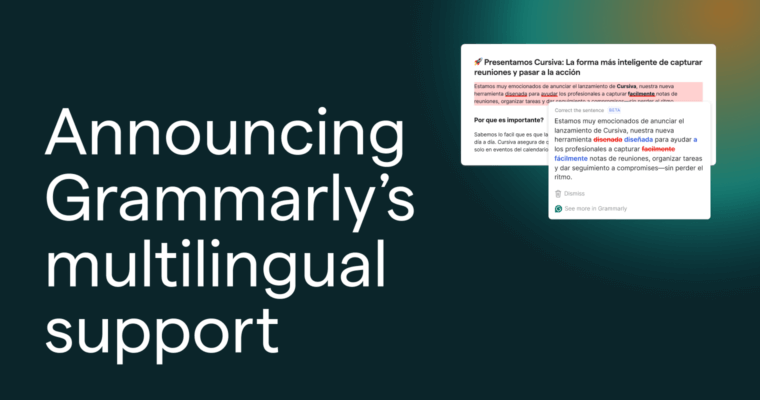
The ability to communicate clearly and be understood is essential to achieving objectives. This is especially evident in the professional world, where miscommunications make it harder for individuals to work together and for businesses to serve customers—and they can quickly add up. That’s why, as the general manager of Grammarly Business, I am proud to have the opportunity to build on Grammarly’s strengths and create a powerful product for teams and organizations around the world.
For years, Grammarly has been pioneering a new category by developing a writing assistant to support individuals in connecting and communicating as they intend. Now we’re growing our product offering tailored for organizational use. With administrative controls and a host of other features to support consistent, strong written communication across teams, Grammarly Business is built to up-level work at organizations of all sizes and types, whether they’re businesses, government entities, nonprofits, or educational institutions.
Scaling up Grammarly’s investment in B2B efforts means building an enterprise-grade organization and product offering we’re truly proud of—one that is integrated within Grammarly’s existing consumer-focused operation while also having our own distinct specialists, teams, and focus. In many ways, the Grammarly Business team operates like a start-up within an established tech company. We’re in an early stage of development and growing quickly, learning fast from our customers and one another, always conscious of making a big impact while ensuring strong values are at the center of everything we do.
Grammarly Business has had wonderful success in our first years—and we know we can do so much more. Thinking about our path so far makes me even more excited about where we’re going through 2020 and beyond.
Seeing the opportunity
The opportunity that lies ahead for Grammarly Business is exciting and humbling. There are tremendous possibilities for growth with a global reach—to create something that is deeply relevant to help organizations perform better. And it’s a pleasure to be able to do this within an organization whose existing business and product are of such quality. At Grammarly there are strong culture and values, robust growth, and big opportunities—all achieved with just a few hundred headcount.
In fact, when I joined Grammarly in 2019, the first thing that stood out to me was that Grammarly is made up of people with impeccable character—people who are not only smart and experienced but also committed to doing the right thing. The team members I met were eager to bring their expertise to the table and proud to extend their mission to organizations.
What was especially compelling to me was how strongly Grammarly’s CEO and co-founders feel about their company values. They are wired into the organization’s DNA and were present in the interactions I had with Grammarlians across teams, in all manner of processes, communications, and operations. Not only that, but tough decisions are made with those values in mind—even when values-driven thinking might be at the expense of an easier “win.”
I also immediately found myself impressed by the opportunity at Grammarly for true global impact. Communication is difficult and complex—that’s a universal challenge. Everyone, myself included, knows what it’s like to struggle with it. And this challenge often stands in the way of people’s potential and their impact, even their progress in life. So helping people get their best thinking across struck me as a big, meaningful, and compelling opportunity.
Testing our hypothesis
Central to the work of Grammarly Business has been the hypothesis that better written communication is vital for companies—it’s not just a nice-to-have. So we set out to show that our product is about far more than just fine-tuning the writing at a company. Early results are clear: improving employees’ written communication helps companies perform at new levels.
There’s often a trade-off between how much workers can get done and how well they can get it done. What amazes people about Grammarly’s impact is that it expands both of these frontiers at once, allowing you to do more and do it better. That’s a direct and measurable improvement to productivity, customer experience, and employee engagement.
What this means is that organizations can address massive hidden costs. Estimates put the silent cost of miscommunication in the thousands of dollars yearly per employee. And framing this in terms of a dollar amount may not fully capture the toll in terms of confusion, lost time, and employee and customer frustration. All of this bolsters our belief that once companies start using Grammarly at scale, they’ll quickly appreciate how valuable it is.
Put another way, we’re beginning to see clear and consistent indications that the hypothesis behind Grammarly Business is correct. The benefit is not only notional but tangible. For companies that are used to operating in a world of trade-offs, it’s powerful.
Expanding our empathy
Grammarly has enjoyed considerable success in helping individuals. Much of that success owes to empathy: Grammarly team members have been able to intuit what people need thanks in no small part to the company’s highly multilingual, multinational workforce.
Translating these strengths to Grammarly Business requires some reorientation. We’re stepping away from Grammarly’s established successes and into less familiar territory, closer to the mindset of a scrappy start-up. We don’t always have direct experience with other industries, for instance, so we have to build new kinds of knowledge. In this context, we’re relentlessly focusing on listening, learning, and internalizing what managers, directors, executives, or other organizational leaders need. The challenges they’re facing to drive results as the nature of work changes are many—and it takes curiosity and humility to understand how we can support their efforts with Grammarly Business.

One example of this kind of approach emerged after the beginning of the COVID-19 pandemic. We saw the challenges facing so many nonprofits and NGOs organizations around the world and wanted to take some action that we could be proud of. Grammarly Business set aside some growth goals and devoted valuable resources to tailor a special offering that could support these organizations. Then we made the decision not to charge for it through all of 2020—or even to request payment information, which many free versions of professional software would require.
Connecting our team directly to our customers
To ensure Grammarly Business is connected with the market, everything we do is about integrating our understanding of the companies using our product. We work closely with customers such as Atlassian, Zapier, and Frost & Sullivan to hear about their needs and consider how we can provide support.
Because we are building a team quickly, we have lots of opportunities to establish collaborative processes and workflows in deliberate ways. Operating as a start-up means we are all in it together, working toward a shared north star. We are building, refining, and scaling with a set of common principles that include maximizing impact, accelerating learning, and empowering everyone to put their best ideas forward.
This can be seen in how we thread our learnings throughout our cross-functional team. Engineers regularly take part in sales calls with customers—a much more direct kind of interaction than gleaning data from a report or simply receiving specs for what to build next from our Product team. They hear clients express with their own words and emotions why and how they rely on our product, and then develop with those ideas in mind. This approach applies across the board—whether you’re coding or working on user interface, or even if you’re developing new systems in accounts receivable, your work is going to be integrally connected to these learnings.
And these efforts aren’t always about shiny new product features. I’ve been so impressed with how much the team has focused on important aspects of building a strong enterprise-grade foundation. Scaling and maintaining the organizational security and data controls outlined in Grammarly’s SOC 2 (Type I) report is an example of this work. These controls are vital for earning and keeping customer trust, and they require exceptional dedication.
Planning our roadmap forward
Our product roadmap stems from these learnings. One exciting development has been our custom style guides. We recognized a common client concern—the need to safeguard consistency in a way that’s scalable and sustainable—and delivered accordingly. It’s already proven itself in areas from brand tone and brand terminology to diversity and inclusion. And as we understand an ever-growing number of use cases, we can ensure that our product is suiting their needs. One customer, Enshored, a business processing organization, recently shared with us how using Grammarly Business helps them bridge culture gaps, work in unison, and create authenticity.
And as we understand an ever-growing number of use cases, we can ensure that our product is suiting their needs. One customer, Enshored, a business processing organization, recently shared with us how using Grammarly Business helps them bridge culture gaps, work in unison, and create authenticity.
That’s the kind of success story we’re out to create. As we’re working to scale a global business, we genuinely want to be finding ways to support organizations communicate better and achieve their goals. We know that how we show up in the market is just as important—if not more important—than any growth targets or financial goals. Those metrics matter, but make no mistake: what we’re building helps people and organizations, and we’re going to keep improving it while holding close to our values.






